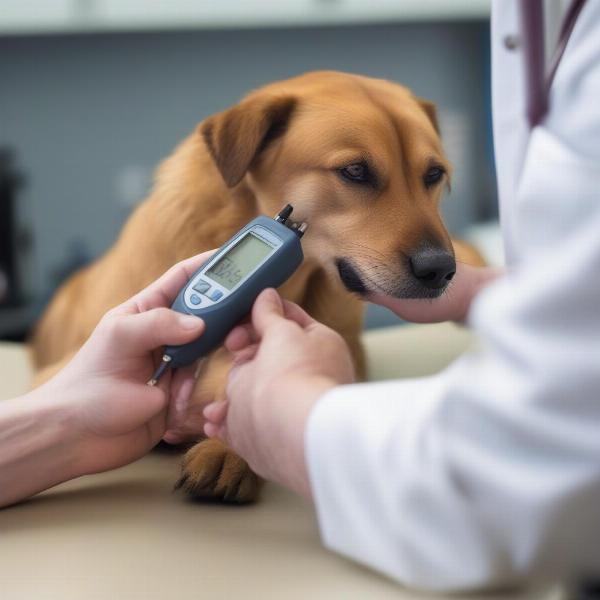Maintaining a healthy blood glucose level is crucial for your dog’s overall well-being. Just like in humans, consistent high or low glucose can indicate serious health problems. Understanding what constitutes a normal dog glucose level and recognizing the signs of abnormal levels is vital for responsible dog ownership. This article will delve into everything you need to know about normal dog glucose, empowering you to proactively manage your furry friend’s health.
What is a Normal Dog Glucose Level?
A normal dog glucose level typically falls between 70 and 120 mg/dL (milligrams per deciliter). While slight fluctuations throughout the day are normal, persistent levels outside this range warrant veterinary attention. Factors such as age, breed, diet, and activity levels can influence a dog’s glucose, but significant deviations can signal underlying health issues.
 Checking Dog's Glucose
Checking Dog's Glucose
Signs of Abnormal Glucose Levels in Dogs
Recognizing the symptoms of abnormal glucose levels is key to early intervention. High glucose (hyperglycemia) can manifest as increased thirst and urination, lethargy, weight loss, and blurred vision. Low glucose (hypoglycemia), on the other hand, can cause weakness, trembling, seizures, and even loss of consciousness. If you observe any of these symptoms, consult your veterinarian immediately.
Maintaining Healthy Glucose Levels in Dogs
Maintaining a healthy weight through a balanced diet and regular exercise is fundamental to managing your dog’s glucose. Feeding your dog high-quality dog food appropriate for their age and breed is crucial. Avoid excessive treats and table scraps, especially those high in sugar. Regular veterinary check-ups are also essential, especially for older dogs or breeds predisposed to diabetes.
Testing Your Dog’s Glucose at Home
While regular veterinary visits are crucial, home glucose monitoring can provide valuable insights between check-ups. This involves using a specialized glucometer designed for pets. Your veterinarian can guide you on the proper technique and interpret the results. normal glucose levels for dogs are generally considered to be between 70-120 mg/dL.
Is Home Glucose Testing Necessary for All Dogs?
Not all dogs require home glucose monitoring. Your veterinarian will recommend it based on your dog’s specific health status and risk factors. It’s particularly beneficial for dogs with diabetes or those experiencing recurring symptoms of abnormal glucose.
The Importance of Veterinary Care
While this article provides valuable information, it’s not a substitute for professional veterinary advice. If you’re concerned about your dog’s glucose levels, consult your veterinarian. They can perform necessary tests, diagnose any underlying conditions, and recommend the appropriate course of action. glucose range for dogs can vary based on various factors and your vet can provide specific guidance.
Conclusion
Understanding normal dog glucose levels is a vital aspect of responsible dog ownership. By being aware of the normal range, recognizing potential signs of trouble, and seeking timely veterinary care, you can help ensure your furry companion lives a long, healthy, and happy life. Don’t hesitate to discuss any concerns about your dog’s glucose with your veterinarian. Remember, proactive care is always the best approach. what is the normal glucose level for a dog is a question best answered by your veterinarian, who can provide tailored advice for your dog.
- What are the signs of low blood sugar in dogs? Weakness, trembling, seizures, and loss of consciousness can be indicators of low blood sugar (hypoglycemia).
- How often should I check my dog’s glucose at home? The frequency of home glucose checks depends on your dog’s specific health condition. Your veterinarian will recommend the appropriate schedule.
- Can diet affect my dog’s glucose levels? Yes, diet plays a significant role in maintaining healthy glucose levels in dogs. A balanced diet and appropriate portion sizes are crucial.
- What should I do if my dog’s glucose is outside the normal range? Contact your veterinarian immediately if your dog’s glucose readings are consistently outside the normal range.
- Are certain dog breeds more prone to diabetes? Yes, some breeds are more predisposed to diabetes than others. Your veterinarian can provide information on breeds at higher risk.
- Can stress affect a dog’s glucose levels? Yes, stress can temporarily elevate glucose levels. Minimizing stress is important for overall health.
- Is there a specific type of dog food for diabetic dogs? Yes, specialized diabetic dog food formulations are available. Consult your veterinarian for recommendations.
ILM Dog is your trusted resource for comprehensive information on dog care, offering expert advice on everything from breed selection and health to training, nutrition, grooming, and much more. We provide practical, up-to-date information to empower dog owners worldwide. Whether you’re a seasoned dog parent or just starting your journey, ILM Dog is here to help you provide the best possible care for your beloved companion. normal bg for dogs is another important topic we cover. For any inquiries or further assistance, feel free to contact us at [email protected] or call us at +44 20-3965-8624. Contact ILM Dog today!